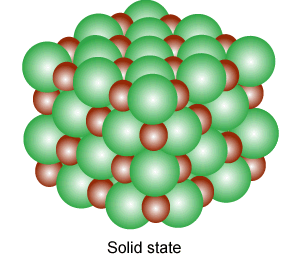A metal M crystallizes into two lattices :- face centred cubic (fcc) and body centred cubic (bcc) with unit cell edge length of 20 and \(25 \,\mathring{A}\) respectively The ratio of densities of lattices fcc to bcc for the metal M is ___(Nearest integer)
A metal M crystallizes into two lattices :- face centred cubic (fcc) and body centred cubic (bcc) with unit cell edge length of 20 and \(25 \,\mathring{A}\) respectively The ratio of densities of lattices fcc to bcc for the metal M is ___(Nearest integer)
Show Hint
Remember the formula for density in crystallography: \(\rho = \frac{Z \times M}{N_A \times a^3}\). For fcc, \(Z = 4\); for bcc, \(Z = 2\). Pay close attention to units.
Correct Answer: 4
Solution and Explanation
The formula for density is:
\[\rho = \frac{Z \times M}{N_A \times a^3},\]
where:
\(Z\) = number of atoms per unit cell,
\(M\) = molar mass,
\(N_A\) = Avogadro’s number,
\(a\) = edge length.
For fcc, \(Z = 4\), \(a = 2.0 \, \text{\AA} = 2.0 \times 10^{-10} \, \text{m}\).
For bcc, \(Z = 2\), \(a = 2.5 \, \text{\AA} = 2.5 \times 10^{-10} \, \text{m}\).
Let \(M\) be the molar mass of the metal. Then the density for fcc is:
\[\rho_{\text{fcc}} = \frac{4M}{N_A(2 \times 10^{-10})^3}.\]
And for bcc:
\[\rho_{\text{bcc}} = \frac{2M}{N_A(2.5 \times 10^{-10})^3}.\]
The ratio of densities is:
\[\frac{\rho_{\text{fcc}}}{\rho_{\text{bcc}}} = \frac{\frac{4M}{N_A(2 \times 10^{-10})^3}}{\frac{2M}{N_A(2.5 \times 10^{-10})^3}} = \frac{4}{2} \times \frac{(2.5 \times 10^{-10})^3}{(2 \times 10^{-10})^3}.\]
Simplify:
\[\frac{\rho_{\text{fcc}}}{\rho_{\text{bcc}}} = 2 \times \left(\frac{2.5}{2}\right)^3 = 2 \times \left(\frac{5}{4}\right)^3.\]
\[\frac{\rho_{\text{fcc}}}{\rho_{\text{bcc}}} = 2 \times \frac{125}{64} = \frac{250}{64} = \frac{125}{32} \approx 3.9.\]
Nearest Integer:
The nearest integer is:
\[4.\]
Top Questions on packing efficiency
- The packing efficiency of BCC unit cell is equal to
- AP EAPCET - 2023
- Chemistry
- packing efficiency
- What is the packing efficiency of simple cubic lattice?
- CUET (UG) - 2023
- Chemistry
- packing efficiency
- Atom X occupies the fcc lattice sites as well as alternate tetrahedral voids of the same lattice. The packing efficiency (in %) of the resultant solid is closest to
- JEE Advanced - 2022
- Chemistry
- packing efficiency
- A metal exists as an oxide with formula $M_{0.96}O$. Metal $M$ can exist as $M^{2+}$ and $M^{3+}$ in its oxide $M_{0.96}O$. The percentage of $M^{3+}$ in the oxide is nearly
- KCET - 2020
- Chemistry
- packing efficiency
- The yellow colour in $NaCl$ crystals is due to
- AIIMS - 2015
- Chemistry
- packing efficiency
Questions Asked in JEE Main exam
Let \( f : \mathbb{R} \to \mathbb{R} \) be a twice differentiable function such that \[ (\sin x \cos y)(f(2x + 2y) - f(2x - 2y)) = (\cos x \sin y)(f(2x + 2y) + f(2x - 2y)), \] for all \( x, y \in \mathbb{R}. \)
If \( f'(0) = \frac{1}{2} \), then the value of \( 24f''\left( \frac{5\pi}{3} \right) \) is:
- JEE Main - 2025
- Differential Calculus
- An AC current is represented as: $ i = 5\sqrt{2} + 10 \cos\left(650\pi t + \frac{\pi}{6}\right) \text{ Amp} $ The RMS value of the current is:
- JEE Main - 2025
- AC Circuits
- The number of points of discontinuity of the function $ f(x) = \left\lfloor \frac{x^2}{2} \right\rfloor - \left\lfloor \sqrt{x} \right\rfloor, \quad x \in [0, 4], $ where $ \left\lfloor \cdot \right\rfloor $ denotes the greatest integer function, is:
- JEE Main - 2025
- Functions
- A lens of focal length 20 cm in air is made of glass with a refractive index of 1.6. What is its focal length when it is immersed in a liquid of refractive index 1.8?
- JEE Main - 2025
- Wave optics
- Two charges \( 7 \, \mu C \) and \( -4 \, \mu C \) are placed at \( (-7 \, \text{cm}, 0, 0) \) and \( (7 \, \text{cm}, 0, 0) \) respectively. Given, \( \epsilon_0 = 8.85 \times 10^{-12} \, \text{C}^2 \text{N}^{-1} \text{m}^{-2} \), the electrostatic potential energy of the charge configuration is:
- JEE Main - 2025
- Electrostatics and Potential Energy
Concepts Used:
Solid State
Solids are substances that are featured by a definite shape, volume, and high density. In the solid-state, the composed particles are arranged in several manners. Solid-state, in simple terms, means "no moving parts." Thus solid-state electronic devices are the ones inclusive of solid components that don’t change their position. Solid is a state of matter where the composed particles are arranged close to each other. The composed particles can be either atoms, molecules, or ions.

Types of Solids:
Based on the nature of the order that is present in the arrangement of their constituent particles solids can be divided into two types;
- Amorphous solids behave the same as super cool liquids due to the arrangement of constituent particles in short-range order. They are isotropic and have a broad melting point (range is about greater than 5°C).
- Crystalline solids have a fixed shape and the constituent particles are arranged in a long-range order.